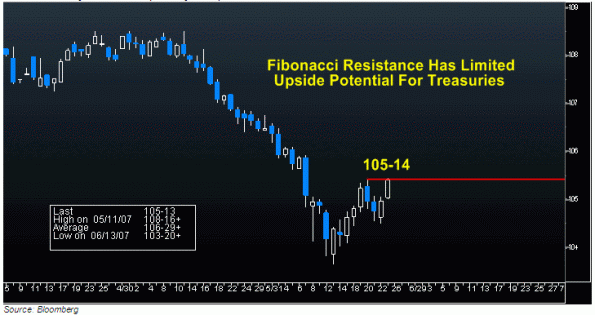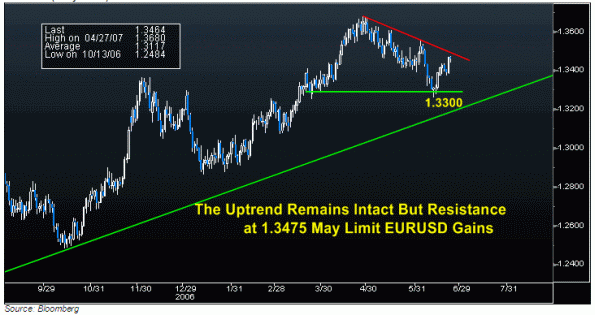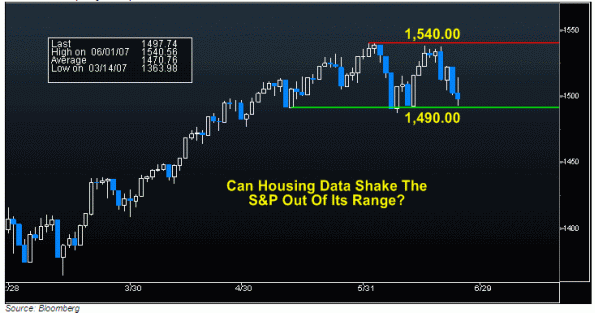| Will US Dollar Losses Continue on Second Round of Dour Housing Data? |
| By David Rodriguez |
Published
06/25/2007
|
Currency , Stocks
|
Unrated
|
|
|
|
Will US Dollar Losses Continue on Second Round of Dour Housing Data?
New Home Sales (MAY) (14:00 GMT;10:00 EST)
Expected: 925K
Previous: 981K
New Home Sales (MoM) (MAY) (14:00 GMT;10:00 EST)
Expected: -5.7%
Previous: 16.2%
How Will The Markets React?
The sole economic release out of the US on Monday sent an unsurprising message: the housing market is still crumbling. The National Association of Realtors said that existing home sales fell 0.3 percent in May to a nearly four year low of 5.99 million from an upwardly revised 6.01 million. Furthermore, the supply of unsold homes jumped to a record of 4.43 million. It has already been recognized that the recession in housing is by far the biggest threat to economic expansion, as first quarter GDP has already ground to a tepid annualized rate of 0.6 percent. While this growth figure is anticipated to be revised slightly higher, the resounding sentiment is that housing will continue to take its toll on the economy as growing supply and higher mortgage rates are only discouraging potential buyers further. Sales of existing homes account for about 85 percent of the US housing market, and new-home sales – which are scheduled to be released at a disappointing 925K on Tuesday morning – make up the rest. The new home report tends to be especially volatile, as homebuilders are far more likely to slash prices and give huge incentives in order to clear inventory, as we saw in April when sales jumped a whopping 16.2 percent. Nevertheless, traders are likely awaiting the FOMC decision on Thursday before speculating on longer-term price action across the US asset classes. While the US central bank is widely expected to leave rates steady at 5.25 percent, markets will be scouring the simultaneous release of the policy statement, as any phrase changes regarding inflation or growth will send prices reeling.
Bonds – 10-Year Treasury Note Futures
US Treasury futures extended their advance fueled by concern hedge fund losses on bets linked to subprime mortgages will become more widespread as the National Association of Realtors reported that home sales fell to the lowest in almost four years. However, gains in 10-year Treasury Note futures were stopped short at Fibonacci resistance at 105-14, with yields closing out the day down 5.5 basis points at 5.297 percent. The release of new home sales on Tuesday could lead Treasuries even higher, especially if flight-to-safety tightens its grip on the markets.
10-Year Treasury Note Futures (Intraday Chart)

FX – EUR/USD
On a longer-term scale, the EUR/USD uptrend remains intact with a supporting trendline formed from the February 2006 lows still holding. However, a cluster of Fibonacci support at 1.3475 -1.3500 may limit any additional gains for the pair, especially as a descending resistance trendline makes its presence known as well. While technical analysis looks towards a EUR/USD retrace down to 1.3300, fundamental data may not work in favor of such a move immediately, as US new home sales are anticipated to fall back -5.7 percent upon announcement on Tuesday. The data will come after existing home sales dropped -0.3 percent during May while the NAHB housing market index signaled overwhelmingly dour sentiment amongst homebuilders last week. With the sector showing no signs of bottoming out – boding increasingly ill for economic expansion throughout the year – there is little reason for the US dollar to resume its rally. However, even bigger event risk looms on the horizon on Thursday, as the FOMC will announce their rate decision, though the markets will immediately focus on the concurrent policy statement for the Fed’s view on inflation and growth. Given the importance of the central bank’s meeting, EUR/USD is far more likely to range trade over the next few days, as market participants will be hesitant to enter definitive positions.
EUR/USD (Daily Chart)

Equities – S&P 500 Index
Financial shares tumbled on concern losses tied to subprime mortgages will deepen, extending the US stock market's decline. The S&P 500 Index fell 0.3 percent to 1497.74 after surging 0.8 percent earlier in the day. Meanwhile, the Dow average dropped 0.1 percent to 13,352.05 while the Nasdaq Composite Index declined 0.5 percent to 2577.08. Shares of Bear Stearns declined $4.65 to $139.10 - the lowest in nine months - after a Merrill Lynch & Co. analyst said the firm may have to salvage another hedge fund. Meanwhile, s decline in sales of previously owned homes sent a gauge of homebuilders in S&P indexes down 1.8 percent to the lowest since July 2004. Lennar Corp., the largest US homebuilder by sales, slid 98 cents to $38.75 while D.R. Horton Inc., the second biggest, fell 28 cents to $20.57.
Home builder shares could continue to pace declines in US equity markets on Tuesday as new home sales for the month of May are anticipated to plunge to 925K from 981K. However, new home sales make up far less of the housing sector as a whole compared to existing homes, which may limit the impact of the release on the markets. Furthermore, Tuesday’s home sales report tends to be highly volatile, as builders are prone to offering dramatically reduced prices and boost incentives in order to clear large supplies of inventories. With the S&P 500 holding within a range of 1,490 – 1,540, economic data may not be able to provide enough fuel to shake the equity index free, especially as traders anxiously await Thursday’s FOMC decision.
S&P 500 Index (Daily Chart)

John Kicklighter is a Currency Strategist at FXCM.
|